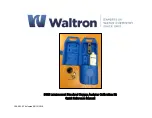
2 Taking Measurements
2.7 Ion measurement (D-53)
D-52/53/54/55
47
Additives and pH range
③
Sample measuring environment
A potential slope measured using an ION electrode
follows Nernst's equation (see page 186) and is affected
by the solution being measured. Also, if the solution is
not mixed well enough, the response becomes slow,
rendering it impossible to measure low concentrations
and causing inconsistent measurements. Calibration
with standard solution and measurement of the sample
should be performed using a temperature bath and while
stirring the solutions.
④
Effects of interfering ions on sample
If the sample cannot be measured properly even after
taking the preventative measures described in items 1
through 3, the solution may contain interfering ions.
ION electrode
Additives (per liter)
pH range
Potassium
K
+
5.9 g/L sodium chloride
(NaCl)
pH 5 – 11
(Ideal is near neutral)
Calcium
Ca
2+
7.5 g/L potassium
chloride (KCl)
pH 5 – 11
(Ideal is near neutral)
Chloride
Cl
-
10 g/L potassium sulfate
(KNO
3
)
pH 3 – 11
(Ideal is near neutral)
Fluoride
F
-
10 g/L potassium sulfate
(KNO
3
)
pH 4 – 10
Nitrate
NO
3
-
No additives
pH 3 – 7
Ammonia
NH
3
4 g/L sodium hydroxide
(NaOH)
pH 12 or higher
Содержание D-25
Страница 2: ......
Страница 11: ...CONTENTS VIII HORIBA ...
Страница 31: ...1 Overview of the Meter 1 9 Using the protective cap D 53 54 55 20 HORIBA ...
Страница 75: ...2 Taking Measurements 2 9 Dissolved oxygen DO measurement D 55 64 HORIBA ...
Страница 139: ...4 RS 232C communications 4 5 Communication example using the HyperTerminal 128 HORIBA ...
















































